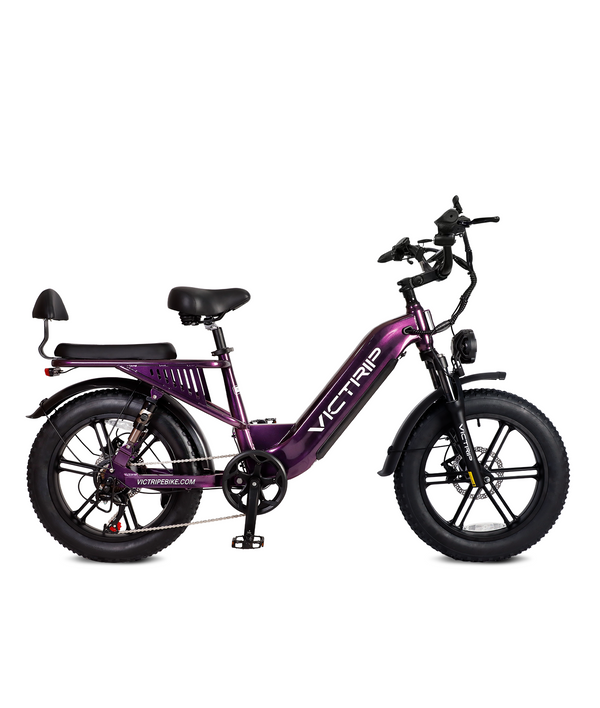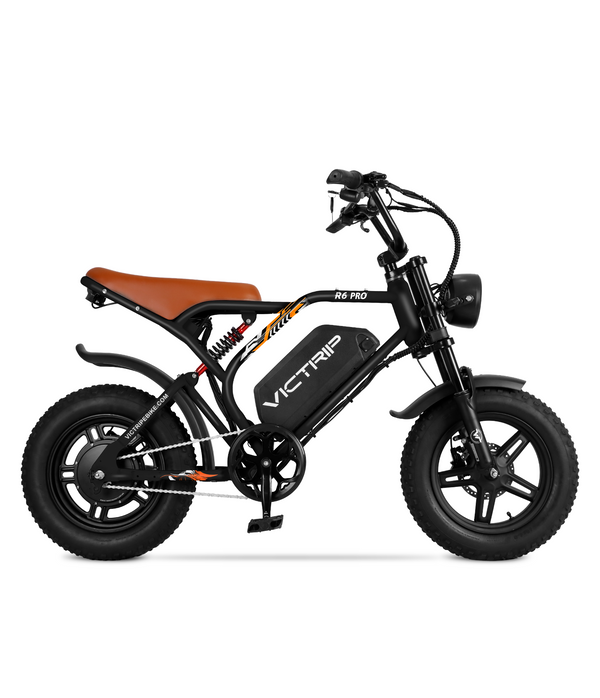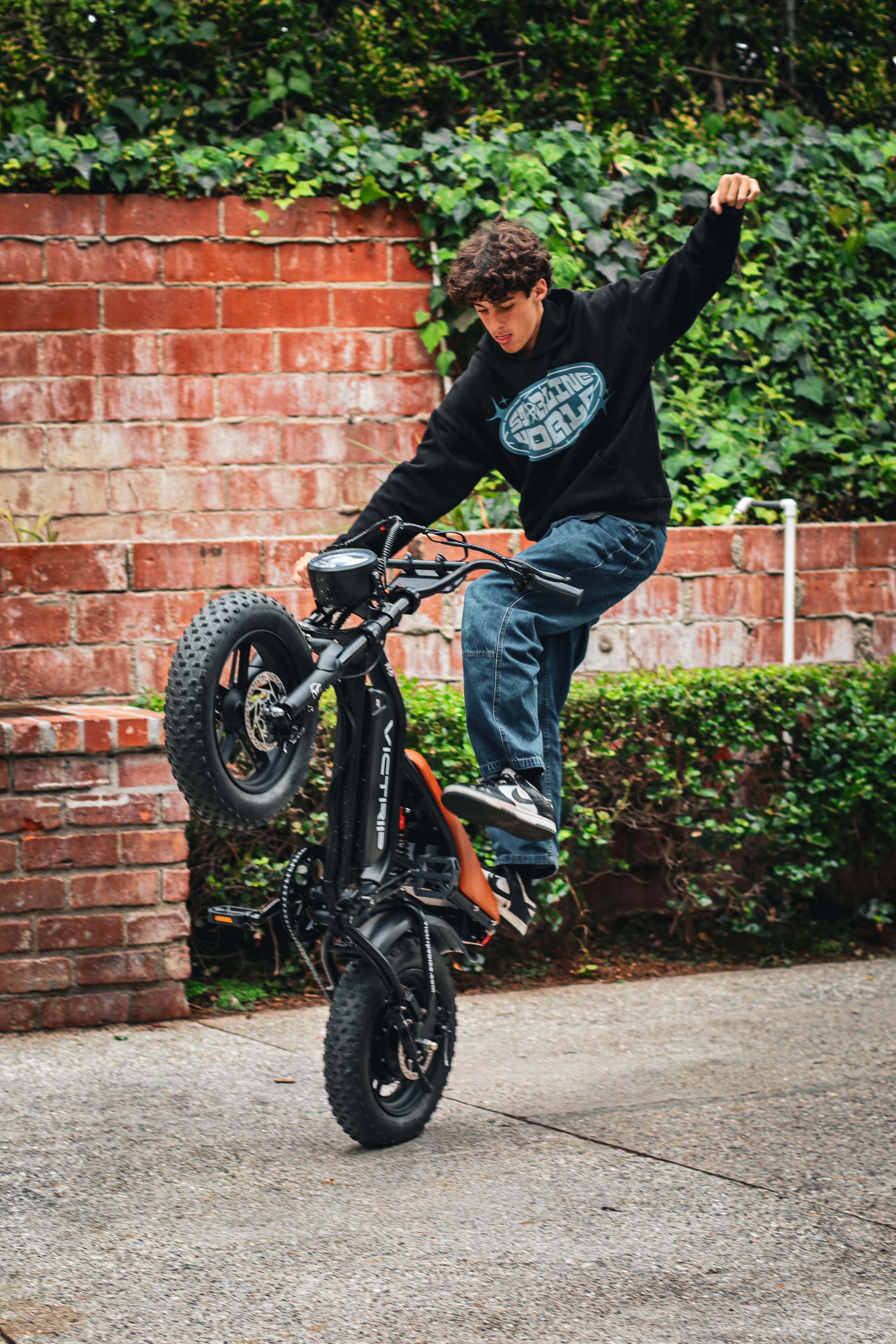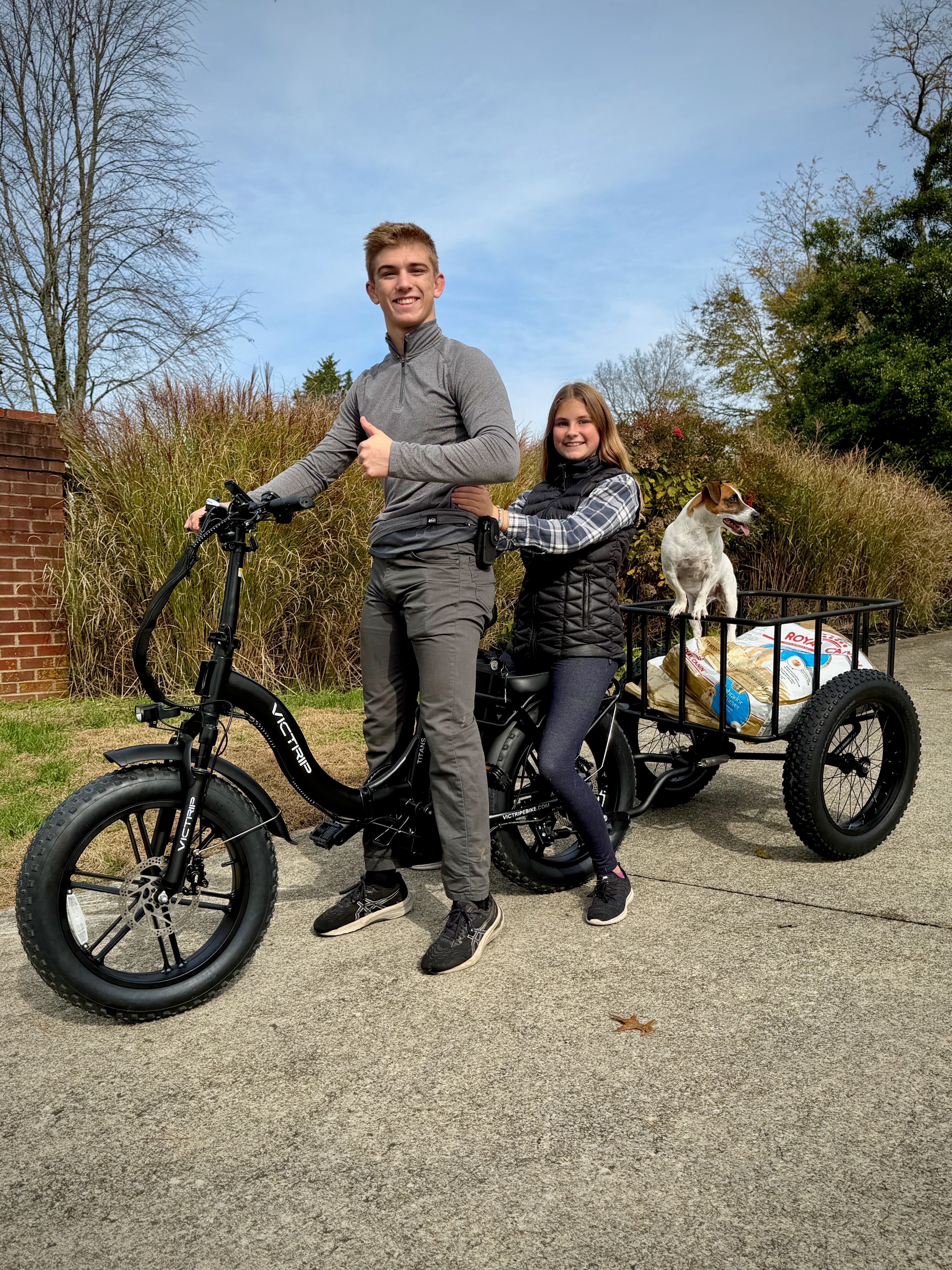Ebike weight limits are the manufacturer's guide to how much combined weight (rider + cargo + accessories) a bike can safely carry. Understanding these limits matters—because exceeding them shortens component life, drops range, harms handling, and may even create legal or warranty problems. This guide explains how limits are set, how to calculate your real-world load, and how to stay safe and get the most from your e-bike.

Why Ebike Weight Limits Matter
Ebike weight limits are not just numbers on a spec sheet — they’re an intersection of physics, engineering, safety, and regulations. When a manufacturer publishes an ebike weight limit, they’ve considered the frame strength, wheel rating, motor torque, brake capacity, and battery thermal behavior. Ignoring those numbers can increase stopping distances, overheat motors or batteries, and cause structural fatigue.
Three immediate consequences of overloading:
-
Reduced safety — handling becomes sluggish; braking distances increase.
-
Reduced range and performance — heavier loads demand more power and reduce battery range.
-
Accelerated wear — rims, spokes, bearings, and frames suffer fatigue faster.
It's important to treat ebike weight limits as a design envelope, not a suggestion. When in doubt, err on the side of less weight or choose a purpose-built, higher-capacity e-bike such as cargo models.
How Manufacturers Define Ebike Weight Limits
Manufacturers usually list a single value for maximum rider + cargo weight, but the underlying meaning varies. Two important concepts:
-
Payload (useful load): The weight the bike can carry — rider + any cargo + accessories mounted on racks.
-
Gross Vehicle Weight (GVW): Total of bike mass (including battery and components) plus payload.
Some firms publish a payload limit (e.g., 120 kg), others a gross vehicle limit. Always check the manual: often a small print or a service doc clarifies the basis. Manufacturers derive limits from component testing, wind-tunnel and torsion tests, and real-world certification. When buying, ask what the published number actually covers.
High-end ebikes like VICTRIP Mimas, for instance, use reinforced alloy frames and upgraded spoke systems that allow for higher total weight without structural stress. The engineering behind such designs ensures riders can carry daily essentials confidently, even on steep climbs or uneven roads.
TOP PICK

VICTRIP® Mimas Electric Bicycles With Torque Sensors
Typical Ebike Weight Limits by Type
Ebike weight limits vary a lot by type. Here are broad ranges (real-world examples vary by brand):
-
Folding ebikes: 100–120 kg payload. Compact frames and smaller wheels limit load.
-
City/commuter ebikes: 120–150 kg payload. Often balanced for everyday riders plus bag.
-
Mountain ebikes (full-suspension): 110–140 kg payload — suspension travel trades off load capacity.
-
Cargo ebikes / longtail / box bikes: 200–300+ kg payload. Built for heavy loads and multiple passengers or kids.
-
Fat-tire / beach ebikes: 130–170 kg payload — larger tires help distribute weight.
These ranges are general; always check your model. If your combined rider + cargo approaches the upper end of the manufacturer’s stated ebike weight limits, consider a higher-capacity model.
How Total System Weight Affects Performance
Total system weight influences multiple performance metrics:
-
Range: Extra weight increases energy used per kilometer. For example, adding 20 kg of cargo may reduce range by 10–20%, depending on terrain and aerodynamic drag.
-
Acceleration and hill-climbing: More mass requires more torque. Motors may hit current limits or thermal cutoffs earlier.
-
Braking and heat: Heavier loads increase brake wear and the need for stronger braking systems and heat-dissipating rotors.
-
Handling: Bike geometry reacts to mass distribution; high rear loads can lift the front wheel or make steering vague.
Because battery discharge behavior and motor thermal capacity are finite, pushing past ebike weight limits can trigger protective modes (reduced power), leading to poor ride experience and potential long-term damage.
Read More: Top Long Range Electric Bikes in 2025 (150+ Mile Range).
Structural Components: Frames, Racks, and Wheels
Many riders think "frame" when they hear ebike weight limits — but several components must share the load:
-
Frame: Triangulation and material (aluminum, steel, carbon) set baseline strength.
-
Fork: Especially with front racks or front-loaded cargo, fork load ratings matter. Suspension forks may have additional restrictions.
-
Wheels and rims: Spoke count, rim profile, and rated dynamic load determine how much repeated stress a wheel can safely take. Low spoke counts + heavy loads = higher chance of rim failure.
-
Tires: Proper inflation and load rating are crucial. Under-inflated tires increase rolling resistance and heat.
-
Racks and mounts: Rear racks are often rated separately — exceeding the rack rating may fail the rack even if the frame is fine.
When checking ebike weight limits, go component by component. A frame might handle more than the wheels or rack — your real limit is the weakest link.
Batteries, Motors, and Heat: Hidden Constraints
Ebike weight limits aren't only structural. Batteries and motors have thermal limits that are influenced by load:
-
Motor thermal limits: Pushing uphill with heavy loads makes the motor draw more current, heating coils and controllers. There are safe continuous power ratings and peak ratings — sustained overload can trigger thermal protection or cause permanent damage.
-
Battery discharge rates: Batteries can provide spikes of power, but higher continuous currents reduce battery life and can create heat that shortens lifespan.
-
Controller settings: Some e-bikes restrict power output if they detect high current draw to protect components — you may notice "power cut" on steep climbs under heavy load.
Thus, even if the frame and wheels look sturdy, the battery and motor design may enforce practical ebike weight limits through thermal protection.
Read More: Comprehensive eBike Battery Maintenance Guide.
Legal, Insurance, and Warranty Considerations
Legal and coverage issues can arise from exceeding ebike weight limits:
-
Local rules: Some jurisdictions have regulations distinguishing types of ebikes (speed/power/class) which interact with weight if the bike is adapted for carrying passengers.
-
Insurance: If you have e-bike insurance (third-party or personal injury), overloading that contributes to an accident may affect claims.
-
Warranty: Many manufacturers expressly state that exceeding stated ebike weight limits voids warranty for related failures (frame cracks, wheel damage, motor burnout).
Document any changes, and read your warranty carefully. If you plan to carry heavy loads frequently, choose a bike built for cargo.
How to Calculate Your Ebike’s Safe Load
A simple step-by-step method to determine whether your planned load fits the ebike weight limits:
-
Find the official spec: Manufacturer’s manual or web page — note whether it’s payload, GVW, or rider + payload.
-
Calculate your base rider weight: Wear what you normally wear for rides. Add any persistent items (e.g., heavy boots).
-
Add cargo & accessories: Bags, panniers, child seats, and water add up. Weigh them or estimate conservatively.
-
Include permanent mounts: Lights, racks, frame bags add to the load.
-
Compare to the stated ebike weight limits. If combined total ≥ 90% of the limit, consider a higher-capacity bike.
-
Margin check: Leave at least 10–15% margin for safety and dynamic forces (bumps, potholes).
Example calculation:
-
Rider: 85 kg
-
Backpack + groceries: 10 kg
-
Child seat and baby: 12 kg
-
Bike (curb weight) irrelevant if manufacturer gives payload; otherwise use manufacturer's GVW guidance.
Total payload = 107 kg → If ebike weight limits are 120 kg, you’re near the top. Consider cargo bike or redistribute.
Real-World Loading Scenarios & Examples
Practical examples help visualize how ebike weight limits play out:
-
Commuter with work laptop and pannier: Rider 70 kg + 7 kg luggage = 77 kg. On a city ebike with a 120 kg limit, this is comfortable.
-
Parent with toddler & groceries: Rider 80 kg + child 16 kg + groceries 8 kg = 104 kg. Now you're pushing a standard commuter — check rack child-seat ratings and wheel strength.
-
Weekend camping on a folding ebike: Folding bike payload 110 kg; rider 75 kg + bags 20 kg = 95 kg. Folding frames and smaller wheels experience higher fatigue; ride carefully and check spokes before long trips.
-
Micro-delivery on a cargo ebike: Cargo bikes are designed for 200+ kg — but distribution matters (center of gravity, secure fastening).
These scenarios show distribution (where the weight sits) often matters more than raw totals. Heavy rear loads may lift the front and reduce steering control. Place dense items low and centered when possible.
Best Practices to Extend Lifespan & Safety
Follow these practical habits to stay within ebike weight limits comfortably:
-
Spread the load: Use both panniers, not a single heavy bag on one side. Balance left-right.
-
Keep heavy items low: Mount heavy cargo near the wheelbase to keep center of gravity low.
-
Check tire pressure and load rating: Inflate to recommended PSI for heavier loads; consider higher-load-rated tires.
-
Inspect wheels and spokes regularly: Look for loose spokes and rim wear—spoke tension should be checked after heavy loads.
-
Brake upgrades: If you regularly carry near-limit loads, invest in larger rotors or better pads.
-
Observe motor and battery temperature: If they get hot under load, shorten trips and let them cool.
-
Service schedule: Increase maintenance frequency when carrying heavy loads (wheel truing, bearing checks).
These small practices keep you within the practical ebike weight limits and prolong component life.
When You Need a Higher-Capacity Ebike
Signs you’ve outgrown your current e-bike include persistent reduction in range, frequent braking fade, wheel failures, or frame creaks. If you regularly carry heavy cargo or transport two people, look for:
-
Dedicated cargo/frame design (rear longtail or front-box).
-
Higher spoke-count wheels, reinforced rims, and stronger hubs.
-
Commercial-grade motors and higher-capacity batteries.
-
Integrated racks and harness points rated for heavy loads.
Purpose-built cargo ebikes are engineered with different ebike weight limits — pick one rather than modifying a commuter bike beyond its specs.
If you frequently exceed 90% of your bike’s payload, it’s time for an upgrade. Models such as VICTRIP R6 Pro feature reinforced frames, high-torque motors, and larger-capacity batteries that sustain heavy-duty commuting, hill climbs, and long-range touring — all while maintaining balanced handling and reliable stopping power.
TOP PICK

VICTRIP®R6 Pro 1500W Moped Style EBike
Modifications, Upgrades & When They’re Safe
You can safely upgrade some things without jeopardizing integrity — but be prudent:
Safe upgrades:
-
Higher load-rated tires.
-
Stronger rear racks rated above your needs.
-
Stiffer wheels with more spokes and higher load rims (professional install recommended).
-
Better brakes (larger rotors, higher-quality pads).
Risky/voiding upgrades:
-
Increasing motor power beyond controller rating — this can overheat the system and void warranties.
-
Welding or structural alterations to add mounts.
-
Using non-rated child seats or racks.
Always consult the manufacturer or a professional mechanic before modifying structural parts.
Top Safety Checks Before Every Ride
Quick pre-ride checks help you avoid exceeding ebike weight limits in practice:
-
Check tire pressure and inspect tread.
-
Verify rack attachments and pannier fastenings.
-
Confirm brakes are responsive; test at low speed.
-
Check wheel spokes for loud clicks or movement.
-
Feel the motor and battery temperature if you recently rode hard.
-
Ensure child seats or cargo boxes are securely mounted.
A 2-minute routine prevents many overloaded-ride hazards.
Conclusion
Ebike weight limits are a practical boundary shaped by structure, wheels, motor and battery design, and safety considerations. Treat those numbers seriously: calculate your real load, distribute it wisely, and upgrade to a cargo-specific bike when necessary. With the right bike and habits you’ll enjoy safer rides, longer component life, and better performance. Remember — carrying smarter beats carrying heavier.
FAQs
What exactly counts toward my ebike weight limits?
Anything you carry that the manufacturer expects: rider weight, cargo, passenger(s), child seats, and heavy accessories mounted on the bike. Check whether the published number is payload or GVW — the manual clarifies.
Can I increase my ebike weight limit by upgrading wheels or racks?
Upgrading to higher-rated components can increase practical capacity, but the frame and motor may still be the limiting factors. Upgrades should be done by professionals and may affect warranty.
How much range will I lose if I add 20 kg to my ebike?
Range loss depends on terrain, speed, and bike efficiency. As a rule of thumb, expect 10–25% less range on mixed urban rides when adding ~20 kg.
Are cargo ebikes safe for carrying two people?
Some cargo ebikes are specifically designed for multiple passengers and have much higher ebike weight limits. Use manufacturer guidelines and proper harnesses or seats.
Will overloading an ebike make it fail immediately?
Not usually — failure is often progressive (increased wear, overheating, or fatigue cracks). However, a sudden impact when overloaded can produce abrupt failures (wheel collapse, frame crack).
Do ebike weight limits vary with temperature or altitude?
Thermal effects can worsen performance: batteries and motors can overheat more quickly in hot conditions, and thin air at altitude reduces cooling and power output. These don't change the physical structural capacity but can lower practical limits.





Share:
Best Electric Bikes Under 1000
Best Electric Bikes Under 1000